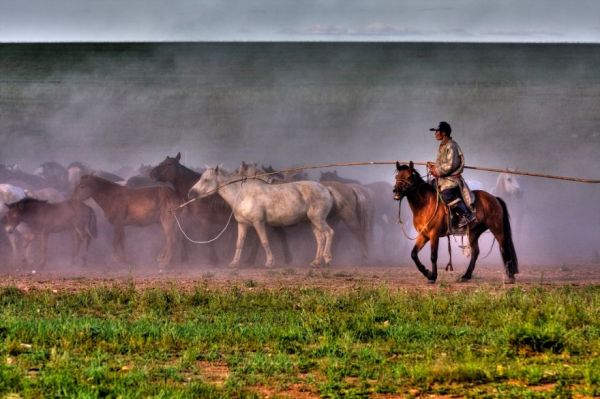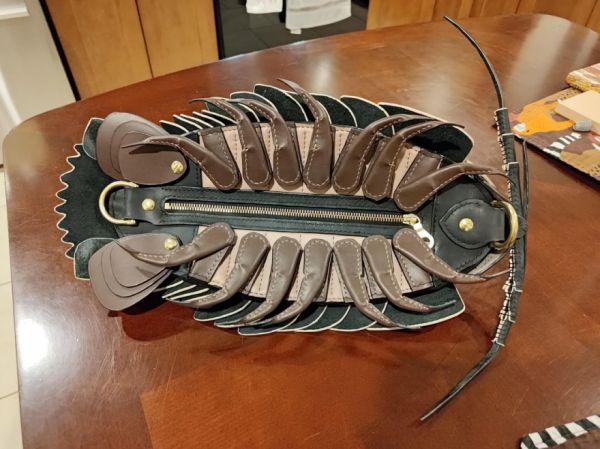What do you do with a car that's 35 years old, has stopped running, and is no good for a trade in? What do you do with a pumpkin that weights nearly a ton and is too tough to cut? Both belonged to one man- Alan Gebert of Millville, Utah, so the answer was to smash them into each other.
The 1991 Geo Metro named Frosty had been a loyal transport for 35 years, and a tribute video about it went viral earlier this year when Gebert retired from his day job. Gebert's plan was to eventually drop a giant pumpkin on it to give the car a fitting sendoff when it quit working, which it did this year. Gebert grows giant pumpkins for fun, and this year's behemoth weighed 1,917 pounds and won first prize at the Utah Giant Pumpkin Festival weigh-off.
The pumpkin drop was staged at Hee Haw Farms in Pleasant Grove, Utah, on October 26th. A crane lifted the pumpkin 14 stories high and dropped it, to the utter satisfaction of the crowd below. Both the pumpkin and the car were destroyed. A similar stunt on the same day at the nearby North Logan Pumpkin Toss produced much less mayhem as a 750-pound pumpkin was dropped onto a minivan, which you can see at the same link.

PlayPhrase is an fun online tool that allows users to search for almost 40 million phrases and locate their usage in thousands of different movies. Choose from six different languages or thousands of particular actors. Watch the video results of the first five within a search for free and then subscribe for unlimited access.
As an experiment, I searched for "look at what you made me do," figuring that, as a commonplace term of psychological abuse, it would appear in films. It shows up in at least ten films, including the 2019 South Korean animated feature Red Shoes and the Seven Dwarfs.
-via Nag on the Lake

Horses were domesticated for meat and milk long after cattle and sheep, about 5,000 years ago. Central Asian horse herders understood the inheritance of traits that Gregor Mendel explained thousands of years later- that you breed the horses that have the qualities you want, and you eat the ones that don't. These early horse herders sped up natural selection by breeding horses for their tameness and obedience to humans. That was the first step.
Then around 4,500 years ago, a horse showed a genetic mutation in its spine that made it much stronger. This was immediately bred to other horse generations. Suddenly, a horse became the most useful animal humans had. Horses could then plow fields, pull cargo, and most importantly, they could be ridden by humans, which revolutionized long distance travel and warfare. Read about the genetic journey that enabled humans to ride horses at 3 Quarks Daily. -via Nag on the Lake
(Image credit: long10000)

In 1850, the total biomass (weight) of all the earth's wild mammals was about equal to the biomass of humans and their domestic animals. As you can see from the graph above, that has changed considerably in the 175 years since. A new study published in the journal Nature Communications traces the changes in that biomass. The total weight of domesticated mammals is more than ten times the total weight of wild mammals! In the domesticated mammal category, two-thirds of that biomass is cattle. We have a lot of them, and they weigh a lot. The other third of that category includes all other livestock, such as sheep and pigs, all cats and dogs, and mice and rats who depend on humans for their survival. Horse populations have declined. You already know about the population growth of humans.
The total biomass of wild land animals has declined, but not nearly as much as that of marine mammals. That decline is mostly the result of hunting whales. The number of whales dropped steeply during the 20th century, and has only recovered slightly since whaling bans went into effect. Read more about these changes and their causes in the published paper. -via Damn Interesting
Laurence Brown contrasts autumn in America and Britain by taking audience questions. Yes, there's a difference, and it's mainly that America is big on autumn. The US is a big country, with an awful lot of beautiful trees. We are an agricultural nation, with a big harvest and a lot of delicious native crops like pumpkins and corn and pecans (turkeys, too). And we are Americans, so we relish making a big deal out of everything.
But the real difference is that Britain is small, and rainy, and autumn doesn't signify all that much change from summer. Brown calls this season the last hurrah before the misery of winter sets in, because he lives in Chicago. Here in the South, we love autumn because it's a reprieve from the misery of a torrid summer. And wherever you live in the US, you can find a place to visit that's very different from your home, without haveing to get a passport. There's a one-minute skippable ad at 2:45.

In 1890, lumber baron John Mouat built a beautiful mansion in downtown Denver for his wife Amelia and his five children. It seems he also built it as a showcase for his lumber business. The first floor has three parlors, the original five bedrooms are on the second floor, and the third floor is a magnificent ballroom. Each room was lined with a different kind of wood, all available from Mouat's company at the time. More than 100 years later, the mansion was restored to its original splendor and turned into an inn and event space.

Current owner Elaine Britten, along with her husband Joel Bryant, love the inn but have decided to retire. Brittan tells us about the spirits that haunt the mansion, which she finds comforting, especially the ghost of Amelia Mouat. However, a little digging suggests that the mansion's past includes an unsolved double murder in 1970.

Yes, this is a bathroom.
That said, the business seems to be doing well, and you can see more of this gorgeous historical home with six bedrooms and nine bathrooms at the real estate listing. -via Fark

Kyle Marcoux is the world's greatest chef. He thinks of new food products that are not simply innovative, but revolutionary. I mean, who would ever have thought that Pepto-Bismol could be consumed in slices?
This Halloween, you're probably going to recieve a lot of candy corn. It's the most popular of all Halloween candies. You--or at least Marcoux--can accomplish much with it, such as this candy corn grilled cheese sandwich.
Oh yes, I completely understand that it's rushing things to bring up Christmas when it's still officially October for another few hours, but this is eerie enough for Halloween. Danny Elfman knows about the macabre. The Oingo Boingo frontman has been the composer for more than 100 movies, including most of the Tim Burton films. Today he presents A Danny Elfman Christmas Story, which he wrote and narrates.
The story is presented in poetic form, in the style of "A Visit from Saint Nicholas" as Elfman tells of how he delivers gifts dressed as Krampus, and of the one Christmas he was confronted by a "fan" who is an actual demon wishing to apprentice under Krampus. That's when things get weird. But as creepy as this one is, you have almost two months to get over it before you welcome Santa Claus into your home, with better results, we hope. -via The Awesomer

The city of Benevento in southern Italy has buildings that go back a couple thousand years, but its reputation as "the city of witches" began in 1428. The Catholic church has begun building a body that would become the Inquisition, and the crime of witchcraft had to be dealt with. Almost anything could be evidence of witchcraft, and confessions could be produced under pressure. Matteuccia di Francesco was convicted of witchcraft and burned at the stake. She wasn't even from Benvento, but her confession contained a poetic sequence, or incantation, that told of witches gathering at a walnut tree in the town of Benevento. Ever since, Benevento has been known for witches (called Janara or Strega), not so much among the residents, but a destination for witches from all over Italy.
Older Benevento residents know all the superstitions to ward off the Janara, but they also embrace the legends for commercial purposes. Benevento became a tourist draw when the local Liquore Strega (advertised in the image above) went into production. The town also has a museum of witches called Janua and is the setting for a series of children's books. Read about Benevento and its witches at Smithsonian.
(Image credit: Halloween HJB)
Hobbiton is the original location of The Shire in The Lord of the Rings movies, meaning that's where those scenes were filmed. The movie sets were preserved, and the area is now a pilgrimage destination for fans. It is also a popular venue for weddings. Sharik and Jess Burgess-Stride are both avid LOTR fans, and held their wedding at Hobbiton just a few days ago. All the guests were wearing Shire attire. Elijah Wood, who played Frodo, was not.
When photographer Cath Ullyett saw Wood walking nearby with his family, she rushed to invite him. Wood was hesitant, not wanting to invade the couples' privacy, but the photographer knew it would thrill them. So Wood ran up to greet the happy couple and pose for a few photos.
It was the first time a cast member had been to any of the many weddings held at Hobbiton over the last twenty years. The bride and groom were ecstatic. -via Geeks Are Sexy
Nirvana - Smells Like Teen Spirit on Rubber Chickens pic.twitter.com/AxELDIg7Eg
— Lord Vinheteiro (@Vinheteiro) October 30, 2025
Fabrício André Bernard Di Paolo, who goes by the name Lord Vinheteiro, is a Brazilian musician who is a classically trained pianist. It's worth noting that he is not actually a member of the nobility of the defunct Empire of Brazil. He is, though, a princely master of many musical instruments, including the rubber chicken.
In the past, we've seen Lord Vinheteiro play "Total Eclipse of the Heart" on a single rubber chicken. Now he plays the most famous work by Nirvana on an array of 14 rubber chickens.
Question: what kind of instrument is a rubber chicken? Some people on the web says that it's a percussion instrument, but I think that the sound comes from the movement of air inside, not the striking of the rubber itself.
There is a species of spider that craves human blood. The jumping spider Evarcha culicivora sniffs out the odors of humans and human blood as well as the blood of animals. But there are two reasons you don't need to worry about being bitten by a blood-sucking spider. The first is that the vampire spider only lives in Kenya and Uganda, around Lake Victoria. And even if you live in those countries, this spider will not bite you. They are around 5mm long, and their tiny teeth cannot pierce human skin.
So how does a vampire spider drink blood? They prey on female mosquitoes that have recently gorged themselves on blood. New research shows that the vampire spider relies more on sight and color than on the smell of blood. They are likely to feast on mosquitoes that have been fed red dye, but have no smell. And even though they eat the mosquitoes that carry malaria, they are no help in controlling the disease since they only eat mosquitoes that have already bitten someone. Read about vampire spiders at Discover magazine. -via Damn Interesting
The international distress signal in Morse code is SOS, but it was never intended to be an acronym for anything. In fact, the three dots and three dashes was once internationally a code for S5S. The backronym "Save Our Ship" is useful when you are learning how to recognize it, so that phrase became a common explanation.
The telegraph and Morse code were developed in the 1840s, but the system was no use for ships at sea because it required wires. But then Marconi gave us a wireless telegraph system, or "radio," first demonstrated in 1896. Suddenly, communications from ships at sea was possible, but it took some time and some left turns to work out standard international codes. The most important was a distress signal, calling any available ships for immediate aid. For some time, this code was CQD. Simon Whistler of Today I Found Out explains how that got (slowly) turned into the SOS signal that we all recognize today, despite the fact that ships no longer use Morse code. -via Laughing Squid
Charles Oldrieve dreamed of one day walking across the English Channel—and perhaps even the Atlantic Ocean. https://t.co/lxePFj5cnV
— Smithsonian Magazine (@SmithsonianMag) October 30, 2025
The early 20th century was full of strange entertainment acts like pole sitters, escape artists, and wing walkers. Charles Oldrieve was a water walker, or an "aquatic pedestrian" if you're fancy. Oldrieve started out as a tightrope walker, but found that novelty acts drew better crowds. He fashioned large wooden shows that resembled canoes so that he could walk across lakes and rivers. He kept setting distance records for walking on water, and dreamed of walking across the English Channel.
But the Ohio and Mississippi Rivers offered a much longer route, and in early 1907 Oldrieve set off from Cincinnati and walked on water all the way to New Orleans! His wooden shoes were specially designed to gain traction in water, and he only walked during daylight. Still, it was a grueling journey through dangerous currents. By the end, he said, "I wouldn’t walk that river again for five times the money I won.” Oldrieve supposedly began the stunt to win a $5,000 bet. Read about Oldrieve's ridiculous but spectacular journey at Smithsonian.

Redditor /u/amp123 made this beautiful handbag that's shaped like an isopod. Given its size, it closely resembles the giant marine isopods that are so popular in Taiwanese cuisine.

She comments that it's functional as a small purse, but will not take large items. She also suspects that it will be an effective deterrent against pickpockets.




